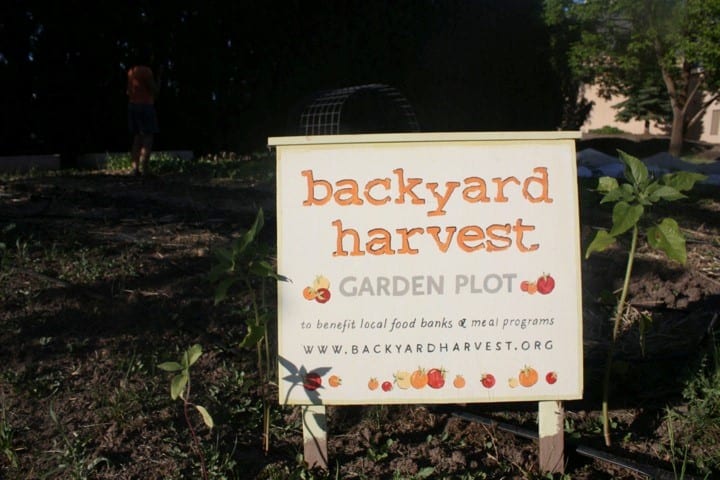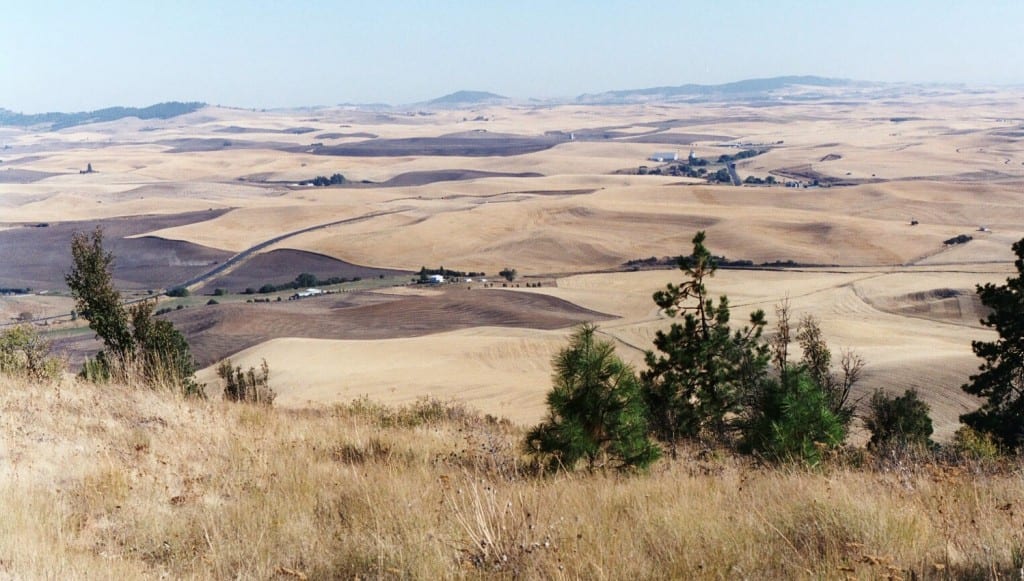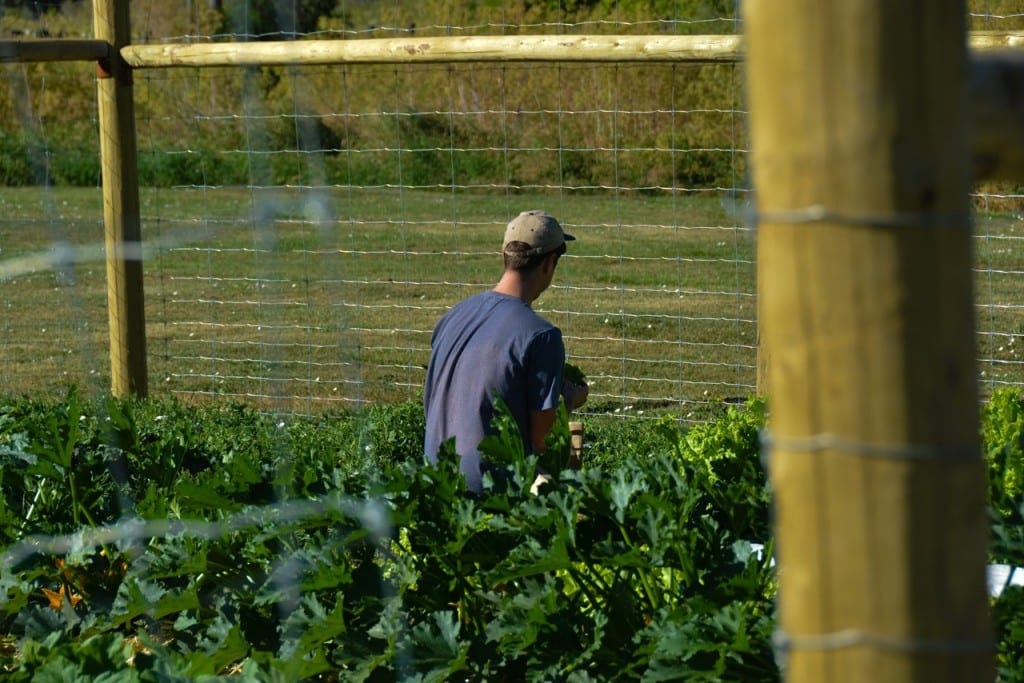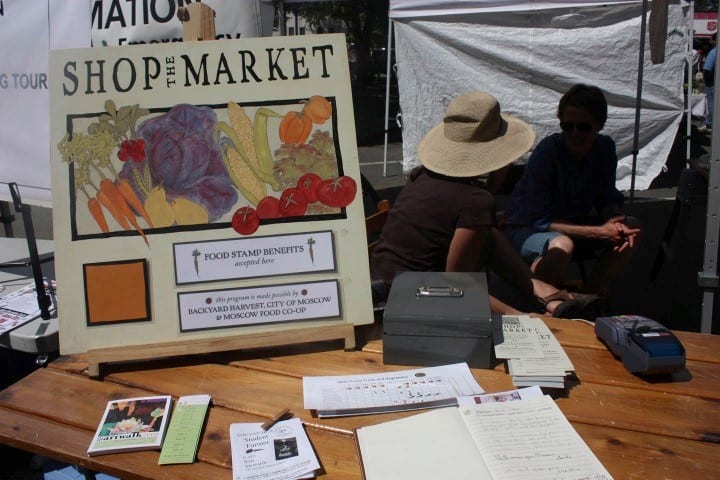In 2014-2015, The University of Idaho’s Department of English and local nonprofit organization Backyard Harvest, Inc. (BYH) received a $5,000 Community Grant from ASLE. They worked together to articulate explicit, compelling connections between local food systems, food security, and environmental justice and sustainability.
The grant assisted BYH in enhancing its communication effectiveness and outreach to the local community. The funding allowed them to hire Jake McGinnis, a graduate student enrolled in the University of Idaho’s English department, who worked with Backyard Harvest to develop creative, compelling education materials, including a brochure, an annotated photographic exhibit, and a public presentation. The grant also supported design, printing, advertising and outreach costs. Below are excerpts from the presentation, which was first given at the ASLE Biennial Conference at the University of Idaho on June 27, 2015.
Food Systems and Community Engagement on the Palouse
By Jake McGinnis
Backyard Harvest grew from a simple idea, to bring fresh, local produce to our communities in the Palouse region of Idaho. We remain focused on gardening for the greater good. Today, our work connects low-income members of the community to high-quality food in three ways—through our Harvest Share and Grow for the Greater Good Programs, by registering and gleaning individual fruit trees and orchards in our Community Orchard Program, and through a collaborative Shop the Market Program, which helps all community members participate in regional farmer’s markets. In each program, our work provides individuals and families with improved access to local food, but we also accomplish something else—our work strengthens our community and contributes to a healthy planet.
From its official beginnings in 2007, Backyard Harvest has been guided by a set of four principles:
First, we believe that small things matter. Governmental agencies and large charitable organizations often overlook small, privately owned sources of fresh food, but our work highlights the impact small vegetable gardens, residential fruit trees, and urban chicken coops can have on a community’s food system. By working with the resources and space already available within a community, we can produce thousands of pounds of produce and make a positive impact on the lives of our neighbors.
Second, a community’s self-reliance is good for the planet. That is, when communities can feed themselves, they eliminate the transportation and packaging costs that rely on non-renewable resources. Our work, though focused on the local, has a significant impact on the larger world.
Third, Backyard Harvest has proven that food grows communities. Sharing the bounties of our backyards brings people together—we have found time and again that when people are engaged in producing and sharing their own food, a community’s sense of common purpose and fellowship is strengthened. By coming together, we are building relationships around food that at once serve the wellbeing of the planet, our communities, and individual lives right here in our backyards.
Finally, our work is guided by an awareness of the problems facing communities across the United States and around the world. The Palouse is a snapshot of the agricultural situation around the world, and our communities mirror others in the United States and beyond. Our success as an organization will be measured by the extent to which our programs influence and shape local food systems across the country.
The Palouse, one of the most productive agricultural regions in the Northwest, is characterized wind-carved silt dunes and a pattern of regular hills and hollows. Those hills, which are made up of glacial outwash soils carried by the wind from areas to the south and west, have proven to be some of richest, and also the steepest and most challenging agricultural land in the United States.
Despite the growing local food systems on the Palouse and in the Lewis Clark Valley, as well as the region’s rich possibilities as an agricultural producer, many residents cannot afford access to locally grown food—especially produce. Three of the four counties that Backyard Harvest works in have recorded poverty rates above state averages. In Whitman County, Washington, the poverty rate is more than twice the state average of 13.6%. Backyard Harvest, by working with the resources that our communities already have, is addressing these issues directly. Together, we can provide fresh, high-quality local produce to our entire communities.
Large-scale agriculture, with its production and distribution linked to global markets, cannot fill the needs of the community members, and especially those of low-income individuals and families. Backyard Harvest, by focusing on the small things—the resources that we already have—can fill those needs in important ways.
Community on the Palouse and the Role of Backyard Harvest
At the most fundamental level, food insecurity asks us to think about our goals for the community that we live in. In other words, what would we, as community members, like the future of the Palouse to look like? Furthermore, how should we move forward?
We can begin addressing the setbacks facing our community today by examining them in light of our past. Until fairly recently, the Palouse supported a large number of low-income families with a healthy, diverse local food system. Longtime members of our community describe a time in the early twentieth century when families supported themselves by cultivating diverse backyard gardens. Today, much of the same space and other resources are still available, ready to help community members in need. Gardens can still provide our community that healthy food that it needs.
Backyard Harvest is addressing food insecurity on the Palouse in three ways—through gardening in space that is already available, by making use of fruit trees and orchards that already exist in the region, and by supporting the ability of low-income residents to utilize the region’s current systems of local food production.
Our oldest program, Share the Harvest, connects community members with extra fruit, vegetables, and eggs to local food banks and meal programs. Similarly, our Grow for the Great Good Program works with church and civic groups to grow food specifically for donation; along the way, participants learn about and establish gardens. Our Community Orchard Program also focuses on making use of the resources that we already have within the community, in this case, a great deal of locally grown fruit. Working with gardeners, volunteers, and landowners, Backyard Harvest has registered over 500 residential fruit trees, berry patches, and grape vines across the region, and we work together to harvest fresh cherries, apricots, plums, apples, and pears for distribution to local food banks and meal programs. Often the fruit that we harvest would otherwise go unpicked. By connecting orchards to food banks and to low-income individuals and families, our work strengthens communities, curbs food waste, and provides fresh fruit to the people who need it the most.
Similarly, our Shop the Market Program focuses on connecting all members of the community to resources what we already have—a vibrant and expanding series of local farmer’s markets. By partnering with various communities and other groups, we allow community members to spend federal food assistance funds, SNAP benefits, at local markets. This program ensures that all community members can participate in these community events, and not only provides SNAP users with high-quality produce, but also strengthens local food systems by supporting small-scale vegetable farmers.
Backyard Harvest and Sustainability at Local, Regional, and Global Scales
Looking toward our best possible future is an important part of what is often called sustainability—a community’s ability to ensure its long-term economic, ecological, and social wellbeing. Recently, scholars working in sustainability studies have turned toward the global challenges to that long-term viability, acknowledging the complex connections between local, regional, and global contexts that are embedded in our communities. In other words, to really address the future of the Palouse, we must also consider its connections to the Inland Northwest, the United States, and the rest of the world. How, for example, is food security on the Palouse tied to global processes, and what can we, as individuals and communities, do about it?
A collaborative, multidisciplinary project sponsored by the Sustainable Idaho Initiative at the University of Idaho, Future Visions of a Sustainable Palouse, presents three possible futures to residents of local communities. One of those possibilities, which emphasizes community connections and food systems reform, points out the resources that our community already has—food distribution platforms like the Moscow Food Co-Op and Farmer’s Market, community support for small-scale agriculture, and collaborative programs like Rural Roots of the Inland Northwest, which works to expand local food markets on the Palouse. The authors suggest that the stepping-stones for a stronger, more resilient Palouse are already coming together around food, food systems, and small-scale agriculture.
Our work at Backyard Harvest is similarly focused on the resources that our community already has—existing fruit trees and orchards, available garden space, and the local food networks that have already developed. Growing extra lettuce or harvesting backyard apples may seem like small work in a global context, but it is also an important shift toward what a community can do right now. The Palouse is a snapshot of the agricultural situation around the world, and our communities mirror others in the United States and beyond. At Backyard Harvest, we hope to establish a model for supporting local food systems and communities across the country.
Backyard Harvest as a Model
Backyard Harvest remains committed, first and foremost, to providing better access to fresh, locally grown foods for low-income families and older adults in northern Idaho and eastern Washington. At the same time, our work, so grounded in our unique communities here on the Palouse, is deeply in touch with the larger forces that impact agriculture across the United States, and we believe that our core beliefs can be exported to other communities across the country and around the world. As part of our founding beliefs, Backyard Harvest maintains that our success will be measured not only by the impact of our work here on the Palouse, but also by the extent to which our programs influence and shape local food systems across the country.




